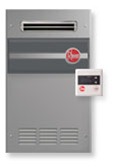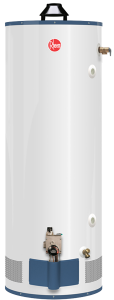Water Heaters
Tank Water Heaters
 Tank Water Heaters provide a large volume of dependable, low-cost hot water. Fuel sources can be propane, natural gas or electricity. They are the most common way to heat water in the United States.
Tank Water Heaters provide a large volume of dependable, low-cost hot water. Fuel sources can be propane, natural gas or electricity. They are the most common way to heat water in the United States.
Residential tank water heaters typically store between 20 and 80 gallons of hot water hot throughout, usually at the factory setting of 120°F. The temperature can be adjusted up or down by a control on the unit. Tank water heaters are typically located in the garage, basement or attic.
Upgrading a standard 5' x 9' bathroom to a master suite or an in-home spa may require upgrading to a larger gallon capacity unit, especially if the new bathroom will include a deep soaking tub with a multi-head shower system. Replacing a tank water heater with another tank water heater is fast and keeps labor costs to a minimum.
Tankless Water Heaters
 Tankless water heaters are today's most popular "green" hot water solution, with the added benefit of actually enhancing the clients' experiences in a luxury bathroom. No matter how many body sprays and showerheads, no matter how deep the whirlpool, your clients will not run out of hot water with a properly sized tankless water heating system.
Tankless water heaters are today's most popular "green" hot water solution, with the added benefit of actually enhancing the clients' experiences in a luxury bathroom. No matter how many body sprays and showerheads, no matter how deep the whirlpool, your clients will not run out of hot water with a properly sized tankless water heating system.
Tankless gas water heaters are more energy-efficient than conventional tank heaters, because they eliminate the need to maintain a large supply of pre-heated water. Tankless units provide hot water on demand at a precise temperature needed, so there is no storage and therefore no need to expend energy heating that stored water.
About the size of a medicine cabinet, tankless water heaters can easily be wall-mounted indoors and even outdoors, depending on the climate. The ability to place a tankless water heater closer to the point of use solves the problem of a long wait for hot water. That problem is not solved by simply replacing a tank water heater with a tankless water heater in the same place. Delays in hot water delivery have to do with where the water heater is located, not the type of water heater.
Tankless water heaters have convenient digital wall-mounted controls and even waterproof remote controls that make it easy for clients to adjust the temperature as often as they wish for convenience as well as safety. Clients might want exactly 120°F for the dishwasher, but only 106°F for the baby's bath time, and back up to 110°F to fill the tub to precisely the preferred temperature for a relaxing soak.
Gas Water Heaters
 The most common way to heat water in the United States is with a tank-style water heater. Tank water heater units heat water even when not in use, to compensate for standby heat loss. Insulation between the storage tank and the outer jacket slows this heat loss, but cannot eliminate it entirely. To maintain a preset water temperature, the water heater must cycle on periodically, even when there is no demand for hot water.
The most common way to heat water in the United States is with a tank-style water heater. Tank water heater units heat water even when not in use, to compensate for standby heat loss. Insulation between the storage tank and the outer jacket slows this heat loss, but cannot eliminate it entirely. To maintain a preset water temperature, the water heater must cycle on periodically, even when there is no demand for hot water.
Tank water heaters generally have about 70% usable capacity, meaning a typical 50-gallon tank has about 30-35 gallons of truly hot water in reserve for usage. If there is high demand over a short period - a family taking back-to-back showers in the morning or a vacation home packed with guests - the hot water can run out. When it does, homeowners have to wait for the water to get hot again.
Current gas hot water heaters contain special flammable vapor ignition resistant (FVIR) technology that prevents the ignition of flammable vapors, such as spilled gasoline, outside the unit. All gas hot water heaters sold since July 1, 2003, must have this FVIR technology.
FREE water Analysis in-home consultation
Water Softeners (rentals available), Iron Filters, Air Filters, Drinking Water Systems
For more information on the WaterCare systems, contact Watertight WaterCare Toll Free - 1-800-937-5370 or use the form below...
[si-contact-form form='3']
Water Softeners (rentals available), Iron Filters, Air Filters, Drinking Water Systems
For more information on the WaterCare systems, contact Watertight WaterCare Toll Free - 1-800-937-5370 or use the form below...
[si-contact-form form='3']
Watertight WaterCare, Inc. is a Waterford WI based water care company.
Servicing
Waterford,
Burlington,
Union Grove,
Racine,
Mount Pleasant,
Caledonia,
Muskego,
Wind Lake,
Oak Creek,
Kenosha,
Delavan,
Elkhorn,
Walworth,
Pewaukee,
Mukwonago,
East Troy,
Lake Geneva,
Waukesha,
Milwaukee,
Brookfield,
New Berlin,
Greenfield,
Franklin,
Wauwatosa
and other Southeastern Wisconsin communities.
Website Design and Internet Marketing by Blue Eye Group LLC



